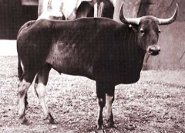 The Kouprey (Bos Sauveli), is a wild ox-like creature that primarily lives in the peripherals of dense, Cambodian monsoon forests, and it was first discovered by the western world in 1937 when one of the species was shipped to the Zoological Garden of Paris. The animal has long been a cultural icon to the people of South-East Asia, and the animal's importance to eastern society was exemplified when, due to its rarity, elusiveness, and mysterious behavior, Prince Sihanouk of Cambodia named the Kouprey the national animal of the country; the animal's importance to all humanity, however, lies in its possible facilitation of the study of genetics. The Kouprey's resilience to disease and its ability to survive in harsh climates may contain information helpful to scientists.
The Kouprey (Bos Sauveli), is a wild ox-like creature that primarily lives in the peripherals of dense, Cambodian monsoon forests, and it was first discovered by the western world in 1937 when one of the species was shipped to the Zoological Garden of Paris. The animal has long been a cultural icon to the people of South-East Asia, and the animal's importance to eastern society was exemplified when, due to its rarity, elusiveness, and mysterious behavior, Prince Sihanouk of Cambodia named the Kouprey the national animal of the country; the animal's importance to all humanity, however, lies in its possible facilitation of the study of genetics. The Kouprey's resilience to disease and its ability to survive in harsh climates may contain information helpful to scientists.Weighing between 680 and 910 kilograms, the Kouprey is an herbivore that feeds on herbaceous vegetation as well as the shoots and leaves from trees and shrubbery; the Kouprey inhabits deep forests that border extensive grassy plains, and it grazes in the grassland at night while retreating into the safety of the forest during the day. The most unique physical feature of the animal is its frayed horns; due to its constant habitual digging, the oxen's horns fray and peel back around the age of three, but they continue to grow following this natural mutilation.
Picture of the kouprey by Liger, licensed under Creative Commons Attribution ShareAlike 3.0
Keywords: white , brown , black , horn , tail , diurnal
The Grey ox, kouprey is listed as Critically Endangered (CR), facing an extremely high risk of extinction in the wild, on the IUCN Red List of Threatened Species
Kouprey habitats
Dry savanna, Forest, Grassland, Savanna, Subtropical / Tropical Dry forest and Subtropical / Tropical Dry Grassland
Custom Search